4.1 Strategy Justification of Mixed Methods
As per the scenario, neither qualitative nor quantitative research could be conducted alone thus the overall process is dependent upon meeting the objective requirements. The methods here used could be observational or exploratory in the process (Jovanovic et al., 2018). As per the level of usage aspects here first it is required to determine usage of different project management techniques in procurement management and thus in the first phase here qualitative method has been evaluated. And the study of quantitative aspects has been evaluated in the second phase in the research report. The main strategy here is about evaluating qualitative methods and then developing quantitative results here. For understanding what factors are affecting project procurement management in the construction industry, how the projects get managed, what kinds of practices and tools are used by them, and analyzing dimensions for project success aspects.
4.2 Unit of Analysis and Study Population
The study population here defines the number of individuals was engaged in data collection. Here the study population has been adopted from the company level and the target population was project managers who were engaged in different project management processes in the construction industry. Here a sample has been drawn from the group population (Ebiloma et al., 2019). The phase 1 study here has been initiated utilizing populations from grade 1 and grade 2 companies s that are dealing with large projects associated with the public-sector. In the phase 2 study here target population group is grades 1, 2, and 3 and this additional grade is associated with medium and smaller projects in the process.

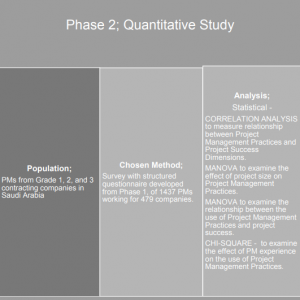
4.2.1 Unit of Analysis
As per the mentioned scenario, the target population associated with the process is project managers who are working in US and UK based countries. Essential factors of research here include the definition associated with unit analysis here. Here PM is chosen as a unit of analysis as it would help in managing concentration about the companies rather than individuals (Akhmetshin et al., 2019). As a project managers used to be responsible for the initial procurement management process and controlling activities such as cost, duration, and the number of employees in the process. Placing the organizational focus here would help in managing project management tools with experience and education in project management practices and ethnicity in the process.
4.3 Phase 1: Qualitative Study
Here the study has been initiated with the initial phase that is associated with interviews for collecting data through evaluating survey questionnaires. Here in this study, a purposive sampling method has been used and the sampling here aims for choosing knowledgeable participants for the process of investigation. The homogeneous sampling technique here has been used for calculating the aspects and analyzing associated participants with relevant characteristics (BELAY, B., 2018). Usually, here purposive sampling gets used as their sample size calculation as this has been evaluated utilizing the non-purposive sampling method.
4.3.1 Sampling Procedure
Here in this qualitative research no such sampling technique has been used and does not directly affect the resulting quality and the process measures quality as per the depth understandings achievements (Famuwagun et al., 2019). The approach associated with deciding the size of the sample here viewpoints has been addressed for each of the interviews. As per the overall approach here in-depth interviews have been accessed here 30 construction project managers have been regarded for participation as per the qualitative study. 15 of the respondents have been responded positively in the process but here 3 have been windrowed. Here the remaining 12 participants have been considered as providing sufficient overview about project success criteria, procurement management, and managing companies of contracts. The PM has been here selected for participating in the process of study according to the criteria of selection as per the mentioned scenarios (Taana, I.H., 2020).
4.3.2 Pilot Study of Interviews
Here a pilot study has been evaluated with 4 project managers before the interventions of 30 individuals. The purpose associated with it was about understanding associated terminology. This here has helped in managing the ambiguity of several questions (Ćutić et al., 2019). Plotting the schedules associated with interviews here helped in changing questions and sensitivity aspects of the questions here also have been maintained as per the requirements.
4.3.3 Analysis of Qualitative Data
Qualitative research in the process used to be an integrated approach associated with the study and collection of data and analysis here has been evaluated in a continuous approach. The process should clear associated objectives related to the research (Grebić, B., 2019). For overcoming associated problems here careful descriptions have been evaluated and categorized in a systematic approach.
The intention of the study was about exploring project management techniques and tools and methodology complications that would help in evaluating cultural factors and success aspects of the procurement stage and overall project success. The process of having 12 consecutive interviews was time-consuming and the evaluated pilot study here helped in identifying associated constraints.
4.4 Phase 2: Quantitative Study
4.4.1 Research Method
For designing the survey here a cross-sectional method has been used for collecting qualitative data. The first phase of the research here has presented aspects of the qualitative approach and that was associated with interviews. Here the second phase is associated with the survey process that helps in mapping factors affecting the project management participation and outcomes. This here helps in correlating variables such as statistical methods such as multivariate analysis and regression analysis. Survey here is used for collecting data utilizing samples presented in the population (Stanitsas et al., 2020). This process here provides detailed information associated with the process and helped in analyzing statistical methods and descriptions.
4.4.2 Response to Survey
The targeted population is associated with the PM study and the list of companies here has been drawn and the list of contracts here is intended for examining large projects. Here the respondents from the companies of grade 1 are considered as 128. The grade 2 data here has been accounted as 144 and grade 3 is 207. Here the following table is presented in the process that represents the respondents and the next table is presented for the percentage of responses here.
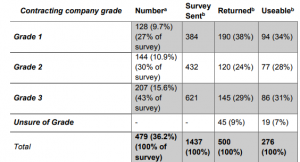
Figure: Distributions of Survey Results
Here three different grade companies have been included in the process associated with 479 registered companies. Here questionnaires have been implemented and the following table represents the response rate of the survey process as per the response rates that range between 10 to 45%.

Figure: Rate of Response
4.4.3 Design of Questionnaires
Here survey questionnaires have been aimed at collecting data and designed for reflecting objectives for the process of research. Robust design about the process here generates results that are reliable and realistic. The detailed results here used have properties such as clarity, and reasons in the process. Here close-end questions have been designed in the process as per the criteria of judging project management methodologies and success (Kononenko et al., 2018). Here tools and techniques in the process of project management have also been analyzed. Personal and cultural background questions here have been associated with the background characteristics.
4.4.4 Data Collection
The pilot study in the initial stage here has been evaluated for removing bugs associated with data. Here study on a small scale as per the process would here evaluate different statistics associated with methods. The pilot study here was successful and analyzed as per the aspects of consideration.
4.4.5 Initial Analysis
Here interferential and descriptive statistics are associated with the data and analysis and the first stage is about setting the questionnaires in a manual process and identifying the unused questionnaires and per the independent and dependent variables. This descriptive analysis was evaluated for descriptive analytics associated with the dataset.
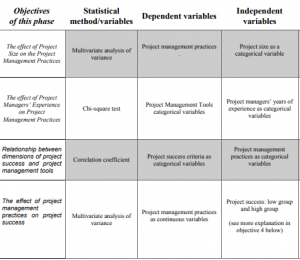
Figure: Statistical Tools and Objectives
4.5 Qualitative Findings
4.5.1 Introduction
This specific phase of the study is associated with response from 30 project managers those took part in the process of interview was 12. Here the first phase is associated with tools, techniques, and methodologies used by contracting companies in evaluating contracting projects. This qualitative research has also aimed in exploring the aspects of the perception of project managers and evaluating the essence of using project management practices. Here they were asked for types of projects they have worked in construction and how contracting companies manage their projects as per the aspects.
This chapter is presented for evaluating findings associated with semi-structured interviews conducted in the process. As per the mentioned aspects here a thematic analysis was evaluated on the interview transcripts which helped in uncovering associated links of answers and themes (Sobieraj et al., 2020). Here themes and sub-themes have been listed in the process of analysis and tests were evaluated as per the replies based on emphasis. Themes associated with analysis here have been providing in the following table:
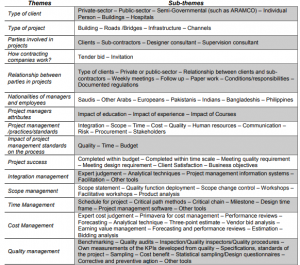
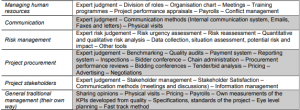
4.5.2 Codes for Thematic Analysis
Codes here are referred to as phrases and sentences that are used in interview responses. Here the codes and sub-codes associated with thematic analysis here have been provided in the following table. Thematic analysis is the accepted method those are essential for analyzing qualitative datasets. These codes here have been accessed for analyzing the true means within the interviews conducted in the process. These themes associated with codes here have been pre-decided and described. For developing the final analysis here it is required to concentrate on 10 areas of management in construction projects accepted as per PMBoK and personal view, acceptance, and familiarity of project managers.
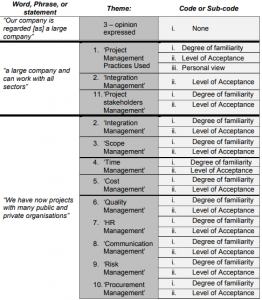
Table: Sub-codes of phrases in the process
Here the table shows the overall analysis aspects and generates additional codes. The associated intent was about providing an analysis of similarities and differences among them. This here allows the process of drawing common meanings of arguments and avoidance.
As per the closer examinations here several statements used to associate with codes and phrases. For the process of occurrence here new codes and sub-codes could be developed for fitting the aspects in the existing framework presented. As per the context, it gets perfectly fit and evaluates appropriateness thus no changes have been initiated. The codes and sub-codes in the process are then referenced with the emergence of data and clear references. Every phrase and line here has been considered for the necessary further attempts.
4.5.3 Clients and Projects- Themes
For the themes, her participants of grade 1 and grade 2 have been asked for describing the associated structure of contractors who were involved in the project constraints. Here almost every participant is reported as per public and private sectors associated with individual clients. Here one of the participant’s has described the fact as:
Public sectors here are associated with monitoring projects and get executed by Government. Here private sector used to be related to executing projects by small businesses and private developers.”
Here another response associated with the process is:
Our company does not get involved with private sectors whether semi-Government projects are gets executed. The associated work for many companies used to be road works, hospitals, buildings, airports, utilities, etc.”
The results in the process are associated with no such differences from the participants from grades 1 and 2. Most of the grade 2 companies here deal with private sector projects and smaller projects than the grade 1 companies. One of the interviews of grade 2 company Pm stated that:
Our company here deals with all kinds of projects and evaluates private-public organizations.”
4.5.4 Themes- major Parties in Projects
For investigating themes here project managers were asked for project involvements during past years. Here the demonstration of results provides the difference in grade 1 and grade 2. Here one of the clients has demonstrated that:
“The system here includes consultant, clients and supervises contractors and also includes engineers for design evaluation.”
From the grade 2 companies, the project managers have stated several different factors. Such as:
Such factors here determine the consequences in overall execution.”
4.5.5 Themes- Project Management Methodology
Project managers here were asked for methods used for managing different projects. The results associated with interviews here have been demonstrated utilizing different methodologies in project management aspects. As per the PM from grade 1 company reported about substances of PMP qualification. As per the statement:
In some of the projects small utilizes traditional project management methodology. It also depends upon the implemented timeframes.”
Here another participant used to provide consistent viewpoints as per the mentioned aspects. Not all the contractor uses PMP qualification aspects or PMI approved methodologies. Here elaborated that:
Here educated contractors to engage in larger projects as they tend to follow all associated PMI guidelines. They here divide the projects in the process in different phases associated with monitoring, implementing, and controlling aspects.“
Here a good example has been evaluated by a project manager about methodology usage and PMP qualifications:
For project procurement management here as per PMP qualification, most of them tend to use the PRINCE2 methodology. Many project managers from grade 1 companies here supported the usage of PRINCE2 in procurement management. One of them stated that:
. This helps maintain the overall data in the detailed and prescribed format for us.”
Here project managers from grade 2 companies stated that they use different methodologies as per the size of projects. One of them stated as:
For larger projects, a well PMP educated team and PRINCE2 methodology get used in the process of procurement management.”
As per the interviewers here several consequences are presents that are regarded with issues. One of the grade 2 participants here stated that:
All the requirements dictated by clients get evaluated in contracts by them. Thus maintaining the project in a professional way becomes necessary.”
Here as per the evaluation of the results here no real consequences are there but include a range of possibilities associated with knowledge and experiences. Here key terms used in their codes are referenced with project management methodology aspects. As per the theme evaluation, it can be said that some project managers use PMP methodologies for the overall project and procurement management process gets evaluated by PRINCE2 as per the basics of evaluation. The usage aspects are not widespread as most of them suggested these two key methodologies as per their suggestions and best practices.
References
Jovanovic, P. and Beric, I., 2018. Analysis of the available project management methodologies. Management: Journal of Sustainable Business and Management Solutions in Emerging Economies, 23(3), pp.1-13.
Ebiloma, D. and Rimtip, M.N., 2019. Factors Affecting the Success or Failure of Project Management Methodologies (PMM) Usage in the UK and Nigerian Construction Industry. International Journal of Innovation and Sustainability, 3, pp.17-28.
Akhmetshin, E.M., Romanov, P.Y., Zakieva, R.R., Zhminko, A.E., Aleshko, R.A. and Makarov, A.L., 2019. Modern approaches to innovative project management in entrepreneurship education: A review of methods and applications in education. Journal of Entrepreneurship Education, 22, pp.1-15.
Famuwagun, O.S., Project Management Methodologies and Bodies of Knowledge in Contemporary Global Projects.
Grebić, B., 2019. Traditional Vs Agile Project Management in the Service Sector. European Project Management Journal, 9(2), pp.55-63.
Stanitsas, M., Kirytopoulos, K. and Leopoulos, V., 2020. Integrating sustainability indicators into project management: The case of construction industry. Journal of Cleaner Production, p.123774.
Kononenko, I. and Lutsenko, S., 2018, September. The Project Management Methodology and Guide Formation’s Method. In 2018 IEEE 13th International Scientific and Technical Conference on Computer Sciences and Information Technologies (CSIT) (Vol. 2, pp. 156-159). IEEE.
Sobieraj, J. and Metelski, D., 2020. Identification of the key investment project management factors in the housing construction sector in Poland. International Journal of Construction Management, pp.1-12.
BELAY, B., 2018. THE EFFECT OF USING PRINCE2 FOR IRRIGATION PROJECTS IN ECDSWC, THE CASE OF KURAZ IRRIGATION PROJECT (Doctoral dissertation, St. Mary’s University).
Taana, I.H., 2020. A Conceptual Framework on The Successful Adoption of Project Management Methodologies in Ghana. Technium Soc. Sci. J., 10, p.409.
Ćutić, D. and Pađen, M., 2019. Project management in government administration. Interdisciplinary Management Research XV, 1 (2019), pp.129-144.










